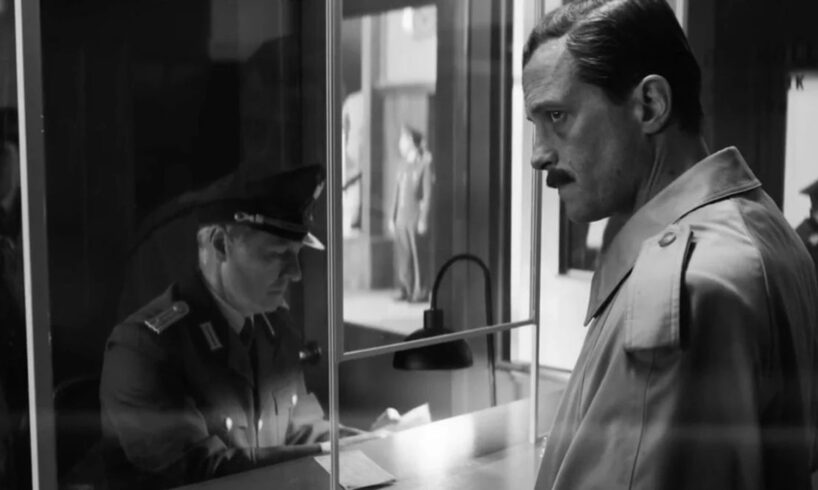
The film The Disappearance of Josef Mengele by Russian director Kirill Serebrennikov, currently showing in German cinemas, is an outstanding work that nevertheless leaves viewers with a feeling of perplexity.
Josef Mengele (August Diehl) arrives in West Germany in 1956 [Photo by Lupa Film, CG Cinema, Hype Studios]
Alongside Adolf Eichmann, Josef Mengele is the most notorious public face of the Holocaust. Born in 1911 in Günzburg in southern Germany to an industrialist family, he sent hundreds of thousands to their deaths as the “Angel of Death” of Auschwitz. He stood at the ramp when the cattle cars packed with people arrived and decided with a wave of his hand who would go straight to the gas chambers (mainly children, pregnant women, the elderly and those unfit for work), who would suffer a slower death through forced labour, and who would be subjected to the cruel medical experiments carried out by the trained doctor and racial theorist and his team.
The film focuses on the thirty years Mengele spent in exile in Latin America after the defeat of the Nazi regime. Mengele had first hidden in Germany for four years and then fled to Argentina in 1949 via the so-called “rat line.” In Argentina the Nazis did not have to fear persecution under President Juan Perón. Old Nazi networks, the Vatican, the Spanish Franco dictatorship and American secret services helped thousands of German war criminals to flee in this way at the time.
The film shows how Mengele, who initially led a comfortable life thanks to the generous support of his family, sinks deeper and deeper into physical and mental decline. The German authorities refused to issue an arrest warrant for the internationally wanted war criminal until 1959, and Mengele could count on the support of South American governments. Nevertheless, he felt increasingly hounded and repeatedly changed his place of residence and country. His fears where compounded when the Israeli secret service kidnapped Adolf Eichmann from Argentina in 1960, even though Mengele was already living in Paraguay at the time and could count on the support of the German-born dictator Alfredo Stroessner.
All the scenes in the film—with one exception, which we will discuss later— are shot in high-contrast black and white and accompanied by a sombre soundtrack. This lends the film a formal austerity that prevents identification with the protagonist and creates an oppressive tension.
Although the camera does not shy away from close-ups of Mengele and the proximity to him is sometimes difficult to bear, the film does not evoke any empathy. It is clearly not concerned with showing the “human side” of the mass murderer, but rather with tracing how his lack of insight into his crimes and his adherence to Nazi racial fanaticism lead him deeper and deeper into the abyss.
In 1958, Mengele was able to celebrate his second wedding with Nazi friends at a lavish party, but he ended his life as a bitter, grey-haired old man in a run-down hovel in a poor neighbourhood of Sao Paulo. He died in a swimming accident in 1979. However, it took years before his body was conclusively identified.
The two-hour film shows a criminal who recites Nazi propaganda over and over again in every possible tone—sometimes in a quiet voice, sometimes screaming. He justifies everything he has done and sees himself as a victim because others did not have to hide and are able to pursue careers in Germany even though they were guilty of similar crimes. At one point, he lists the names of several doctors with whom he worked in Auschwitz and describes in detail the brutal methods they used to torture the objects of their research to death. The older and more bitter Mengele becomes, the more violent are his racist outbursts, ultimately repelling even his closest helpers and friends.
August Diehl plays Mengele masterfully. Born in West Berlin in 1976, the actor has appeared in several dozen films and is a member of the ensemble of the Burgtheater in Vienna. WSWS readers may know him best for his outstanding portrayal of Marx in Raoul Peck’s The Young Karl Marx.
Diehl embodies Mengele over a period of four decades—from the cheerful SS officer in Auschwitz to the old, choleric man in Brazil. The film repeatedly moves from one time period to another. The plot does not unfold chronologically, but jumps back and forth—which makes the protagonist’s changes even more apparent.
The film’s screenplay is based on the 2017 novel of the same name by French author Olivier Guez, who spent three years conducting intensive research for the book. Guez is well versed in the subject matter. He also co-wrote the screenplay for the film The People vs. Fritz Bauer, which focuses on the role of the Frankfurt public prosecutor in tracking down Adolf Eichmann. Bauer, who in 1963 initiated the first Auschwitz trial in Germany, bypassed the German government and contacted the Israeli secret service because the Adenauer government was covering up for Eichmann.
Although the film focuses entirely on Mengele as a person, it paints a devastating picture of German society—or rather, its ruling elites. They have as little sense of wrongdoing as Mengele himself.
A key scene in the film is Mengele’s historically documented visit to his family in Günzburg in 1956. The German embassy in Argentina had issued him a passport in his real name, which allowed him to enter the country unmolested.
During a family dinner served by four liveried servants, the staunchly conservative family patriarch (played by Burghart Klaußner) and one of Josef Mengele’s brothers try to convince him to stay in Germany. As the largest employer and patron of the city, there was nothing to fear in Günzburg, and as far as the federal government was concerned, Adenauer’s Minister of the Chancellery, Globke, co-author of the Nuremberg Race Laws, had himself contributed to the segregation of the Jews. There, too, there was no interest in taking action against Josef Mengele. But he considered the risk too high and travelled back to Argentina.
Rolf Mengele (Maximilian Meyer-Bretschneider) with his father in 1977 [Photo by Lupa Film, CG Cinema, Hype Studios]
Another key event that the film returns to several times is the visit of Mengele’s adult son Rolf to his father two years before his death. Rolf is a typical child of the post-war generation—long hair, jeans and liberal views. He travelled to see his father secretly because his family asked him to. Now he wants to know whether Mengele really did what he is accused of doing in Auschwitz. But he gets no answer. Mengele evades the question, accuses Rolf of falling for Jewish propaganda, agitates him with Nazi propaganda and demands that he cut his hair before he will talk to him seriously.
After this first clash with his son, Mengele’s thoughts wander back to Auschwitz. These scenes, shot in the style of an amateur film, are the only ones in the film that are in colour. It was apparently the happiest time of Mengele’s life. We see him flirting with his first wife at a swimming lake— and we see him selecting people at the ramp and carrying out his human experiments. The scenes are difficult to watch.
Rolf repeatedly tries to find out the truth. In the end, his father throws him out. Nevertheless, he says goodbye with a hug the next day.
The film paints an impressive picture of Mengele as an incorrigible Nazi and his entourage, who protect and support him. However, what conclusions should we draw? The film gives no answer, not even a hint. As one reviewer put it: “Kirill Serebrennikov’s film does not provide any easy answers; it stirs, disturbs and asks uncomfortable questions about history, entanglement and responsibility.”
This is no small thing. At a time when right-wingers and fascists are on the rise again in numerous countries—from the USA to Italy and France to Germany—these questions are important. Both the lead actor, August Diehl, and the director, Kirill Serebrennikov, have emphasised the film’s current relevance.
At a press conference, Diehl explained that Mengele was no exception: “These are people who spring up like mushrooms in a certain system, in war situations, in dictatorships, because they are suddenly needed. A dictatorship needs psychopaths. They suddenly get completely normal jobs, for example as police officers or doctors. And that’s the case everywhere, even today.”
Diehl continued: “I think that in a healthier society, these people would not rise so high. In a sick society, on the other hand, they rise very high. That was also a very important insight for me: these systems still exist in our world. The situation is really terrible at the moment, which may also have something to do with the fact that a certain culture of remembrance is not being cultivated, that we are forgetting these people, forgetting these phenomena, that things are actually repeating themselves …”
Diehl makes an important point here. Society is indeed sick. The reason, however, is not simply the lack of a culture of remembrance, but the capitalist basis of society. Eighty years after the end of the Second World War, Germany’s ruling class is once again preparing for war against Russia, while historians revise German history to justify fascism. The film deserves a wide audience.
Sign up for the WSWS email newsletter





